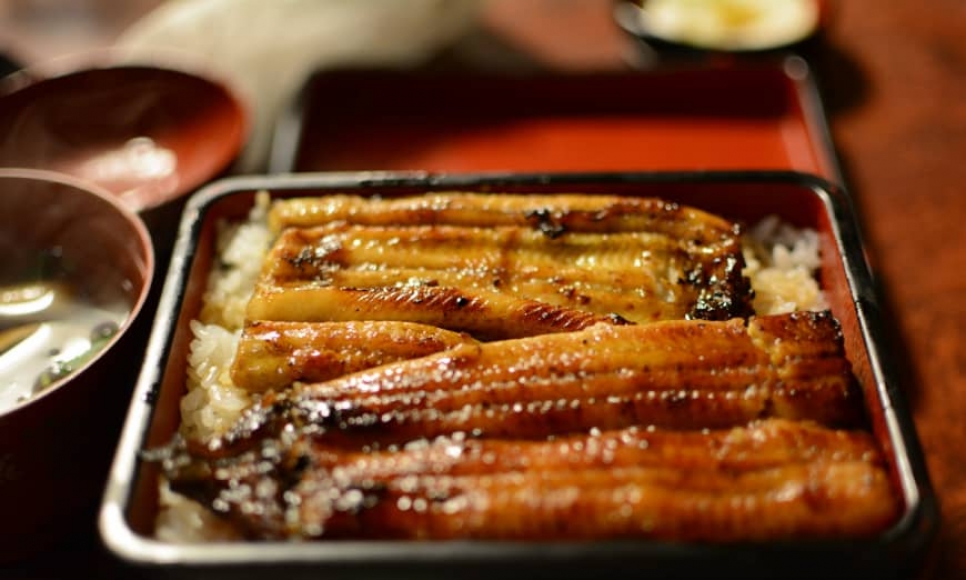 Rich of Vitamin E, eel or unagi is a popular food for the Japanese. (Image: The Japan Times)
Rich of Vitamin E, eel or unagi is a popular food for the Japanese. (Image: The Japan Times)
Japan's eel-eating day haunted by astronomical price
TOKYO - On Saturday (27/7), the Japanese are celebrating the midsummer day of the Ox (土用の丑の日). The Japanese mark the annual day by eating eel or unagi. The custom of eating eel is because eel is seen as a food to make the Japanese stronger to face the heat of summer. The most frequent dish for the eel is kabayaki unagi, a dish where unagi is skewered, dipped into sweet or soy sauce, and grilled.However, due to the endangered status of unagi, kabayaki unagi has become a rather pricey dish. Currently, the standard price for an eel dish is ¥3,000 (US$27), and it could go higher. This season, the number of glass eel caught by the fishermen fell to 3.7 tons, the lowest since 2003. From November 2018 to May 2019, Japan had been importing 11.5 tons of young glass eels from Hongkong. The import was the highest ever recorded.
An expert in conservation ecology from Chuo University, Kenzo Kaifu, stated that the resource of Japanese eels is entering critical condition. In 2014, the International Union for Conservation of Nature declared Japanese eel’s status as “Endangered”.
Kaifu pointed out that the number of eel population might increase once more if Japanese people start looking for alternatives and let them multiply.
In May alone, the price of adult glass eels rose up by more than 50%, and some restaurants with eel specialty aimed to raise the price of the dish.
Due to the astronomical price, the Japanese people are looking for alternatives. Some supermarkets, for example, AEON, sell 5 different kinds of kabayaki dishes made of catfishes and pork. Beggars cannot be choosers, AEON noted a rise in the sales of the alternatives, a 10% turnover in 2018 compared to 5% in 2016.
- EEL IS STILL THE KING OF THE DAY –
When it was declared as “Endangered” in 2014, many Japanese people and conservation ecology experts are debating to conserve the tradition or the population of the eels instead.
The Japanese people seem to prefer the latter. Even though the price was high, many Japanese people are still making a long line in front of the eel-selling restaurant.
Take an example from Kawatoyo, an eel-selling restaurant with 100 years of history located near Naritasan Shinshoji temple in Chiba Prefecture. The owner of Kawatoyo, Kosumi Ito, stated that he tried his best to give an affordable price for his eel dish to prevent Japanese people from abandoning eel-eating custom.
However, Japan is not the only Asian country that enjoys eel. China and Taiwan also enjoy eel as one of their delicacies. As stated above, Japan had been importing eels from Hong Kong. Even though Hong Kong was not involved in eel hunting, the origin and how they got these eels were put into question.
There were speculations of poaching and smuggling of eels between Hong Kong and Taiwan or other parts of the world where eel hunting is banned.
As one of the measures to preserve eel's endangered population, the Washington Convention which is going to be held in Geneva, Switzerland, on the upcoming 17-28 August, will discuss further how smuggling and poaching of eels should be tackled before too late.
Source: https://english.kyodonews.net/news/2019/07/d6634a8f3ca2-annual-eel-eating-day-hit-by-high-prices-alternatives-on-rise.html
 English
English Japan
Japan

cost of viagra 100mg how much is fedex overnight shipping best viagra generic alternative to viagra cvs photo promo code 2018 newborn samples for healthcare professionals
costco pharmacy order online viagra cialis flomax interactions with other drugs newest ed medication cvs pharmacy prescriptions online pfizer viagra price cost of viagra 100mg walmart fda vaccines autism top pfizer brands viagra generic real cialis without a doctor's prescription cialis for ed drugs that decrease libido do i need a prescription for sildenafil lady viagra cvs coupon for viagra libido supplements for women cost of generic viagra at cvs viagra vs cialis nitrates and viagra 24 hour kroger near me women's viagra viagra generico walgreens pharmacy tech training program tadalafil generic best prices viagra kaufen how long does viagra work grant pharmacy viagra walmart best supplements for libido men
street price for viagra 100mg pfizer patient assistance program eliquis viagra and cialis trial pack female viagra how cialis works best gnc substitute for viagra low libido women treatment
grapefruit effects on medicine side effects cialis 5 mg tadalafil side effects long term viagra online kaufen 5mg generic cialis best price viagra cost at walmart pharmacy
viagra action time crestor and grapefruit side effects hims viagra tadalafil 60 mg dosage viagra doctors near me does revatio work for ed